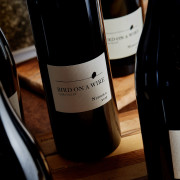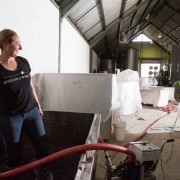Storing Wine Through Time
Wine has been an intrinsic part of society for many centuries, used in religious, celebratory and culinary rituals. As one of the world’s most popular drops, this beverage has seen its fair share of change throughout history. From ancient Georgia to Greece, founding wine-makers through time have worked tirelessly to come up with storage solutions to best stabilise temperature, humidity and vibration. While today’s wineries have the luxury of choice, when choosing vessels, this wasn’t always the case. There has been a diverse range of vessels used, some which have come by chance, some by design.
1. Wineskins
Known as the ‘original wine glass’ wineskins date back to Ancient Greece and were first referenced in biblical tales and literature. In these stories, a wineskin was used when wine was moved from a fermentation vat and transported home or elsewhere. At that time, a wineskin consisted of a goat’s bladder or skin, although today other animals are also used. This form of storage was favoured, as it was easily transportable and light. However, due to the organic nature of the material, wineskins did not stand the test of time and were soon replaced with more practical solutions. Interestingly enough, in Shakespeare’s time, wineskins were considered a ‘must-have’ for wine-enthusiasts, much like the screw-top bottle of today!
2. Qvevri
Pronounced “kway-vree”, the Qvevri originated in Georgia and is some of the oldest wine-making pottery on earth. Known for its egg-shape and terra-cotta earthen clay, its main advantage is its ability to store wine in large quantities whilst keeping it cool. Large in size, these pots were used in all steps of the winemaking process. Lined with beeswax the clay pots were part of the grape crushing, fermentation and long-term storage process. Once filled, these pots were stopped with a large cork and buried underground, letting the earth provide natural regulation. This process ensured the wine stayed cool, at a stable temperature and protected the freshness of the Georgian’s precious vino. Qvevri are still used today by some winemakers across the world.
3. Amphorae aka clay pots
Much like the Qvevri, these pots originated in Ancient Greece/Rome and were made from clay. Derived from the Greek word amphoreus, meaning ‘a jar with two vertical handles’, the amphorae is as its etymology implies; a long slender pot with two handles. Used for the transportation of, not only wine, but olive oil and other foods, the invention of the amphorae was game-changing for international trade. Standardising wine quantities and allowing the shipment of hundreds of gallons to neighbouring countries, these pots were shipped en masse. Hung like grapes, amphorae made wine trade easier and much safer!
4. Barrels
In the age of The Roman Empire, the wine barrel we know and love today came to be. Introduced by the Celtic Gauls, this invention quickly skyrocketed to become the most popular storage solution in the world for wine. Taking the market from the amphorae, which until then was the most-widely used wine vessel, the wooden barrel became widespread across the globe by the third century AD. Oak wood, which is now synonymous with wine barrels, was actually originally used because of its widespread availability, as there were many Oak trees in Europe then. It’s trademark ability to bend, also made it an obvious choice. However, at that time, no consideration was given to its wine-aging abilities or flavour contribution which came about as an apparent ‘happy accident’ of using oak staves.
5. Bottles and corks
This tried and true vessel is one we know well. It holds almost all of the world’s vino and has become known as the quintessential symbol of wine. According to wine historians, the Speyer wine bottle (or Römerwein) is the oldest known wine vessel, unearthed from a Roman tomb near Speyer, Germany and dating back to the 4th century AD. However, when coal-fuelled furnaces became popular, in the 17th century, the recognisable wine-bottle of today was formed, with a thicker form of glass to make it feasible for wine storage. As ageing wine became more important, the shape of wine bottles changed, to a longer style, to enable the storage of bottles on their side. While amphorae were sealed with weeds, reeds, grass or wet clay, the wine bottle called for something more durable. At about the same time, an Englishman by the name of Robert Hooke, invented the first cork to seal wine and, with that, today’s ubiquitous wine bottle was born.
6. The oldest wine jar
Over the years archeological sites have uncovered many forms of pottery indicating that the origins of wine are closely linked to that of human beings. According to historians, pottery pieces have been found which date back around 8,000 years. The Penn Museum actually contains one of the world’s oldest wine jars, dating to 5400-5000 B.C. It and five similar jars were set into a clay kitchen floor of a well-preserved Neolithic house at Jahi Firuz Tepe, Iran. A red residue was found inside the jar and tested positive for grape and tree resin. The jar is said to have held around 2.5 gallons of wine.
7. Australia and wine origins
Australia’s first-known history of wine can be traced to its settlement in 1788, when Arthur Philip brought vines with him on the First Fleet. Some of the oldest vineyards in the world are now located in Australia, with vineyard pests like Phylloxera and socio-economic changes forcing vignerons to rip out older vineyards in other locations. The Barossa Valley has vineyards dating back to 1853, and Victoria has old vines at Best’s Wines, Tahbilk and through parts of Rutherglen believed to have been planted between the 1860s to 1930s. The Yarra Valley established a name for producing impressive table wines from the 1850s, with varieties like shiraz, cabernet sauvignon and marsanne.
Given how recent Australia’s winemaking history is, local winemakers have borrowed a great deal from history and particularly from European wine practices. While, for the most part, oak barrels are the prominent option for wine storage, you will find a range of oak vat sizes from various regions and coopers, as well as steel tanks, concrete vessels and we are seeing some interesting amphorae in wineries too. Wine producers have provided us with many storage solutions through history and it is reassuring to find these ancient vessels are still a part of our winemaking, in a much more technologically modern and commercial industry today.










